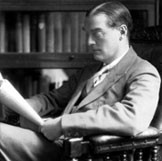Dick Harris
 Dick Harris
Dick Harris
Walter Bruce Harris was always known as ‘Dick’ to his friends and family but as ‘Harry’ to the school. He was born in 1888 and was seven years younger than his famous brother, Stanley Harris. However he followed in his footsteps to both Westminster and Pembroke, gaining a first class degree in History.
Like Stanley, Dick was a talented sportsman. He won consecutive football Blues in each of his three Cambridge years (1908/09 to 1910/11) and played in the matches against Oxford that took place in February 1909, February 1910 and February 1911. In a sense, Dick did better as a Blue than Stanley, who also won three Blues. But Stanley didn’t win a Blue as a freshman, as Dick did, and Stanley’s final Blue came after he had taken his BA.
On coming down from Cambridge in 1911, he joined the staff at Lancing College. Dick remained at Lancing as a schoolmaster until the end of the summer in 1917, when he was succeeded as Head’s House Tutor by G A Brown. Evelyn Waugh was in Dick’s tutor group for his first term in May 1917 and later in life Waugh said that he might have left Lancing early if it hadn’t been for Dick Harris.
Dick finally joined up for war service at the same time as his friend J F Roxburgh and they both went into the Royal Engineers Signals Corps . He and Roxburgh were fellow Lancing Housemasters and were particularly close. Roxburgh went on to found Stowe in 1923 and become one of the great headmasters of the twentieth century, ranked alongside Sewell of Radley and Arnold of Rugby.
Dick didn’t go to France until 22nd June 1918. If, at that point, as seems probable, he joined the Signals Company of the 33rd Division of the British Expeditionary Force, he would have been out of the front line until September when the Division joined the final advance across northern France. At all events it is certain that he ended the war near Berlaimont on the Sambre, where in the first days of November, he took part in a famous battle for the crossing of the River Sambre with the 33rd Machine Gun Corps, under Lt Col G S Hutchison, DSO MC.
In the school’s archive there are three photographs of the 33rd Machine Gun Corps’s victory march on Armistice Day, 11th November 1918, through the streets of Locquignol, just west of Berlaimont. Each photo shows part of a column of troops marching behind an officer against an identical background. The officers featured are G S Hutchison, we believe, and Dick Harris and J F Roxburgh.
In 1919 he returned to Lancing to resume charge of football and was appointed Housemaster of Gibbs’ House.
In 1926, Dick honoured his pledge to his dying brother and took up the headship of Saint Ronan’s. The school’s reputation continued to flourish under ‘Harry’ and he continued to foster a more enlightened form of education than practiced in many other schools at the time. A mantra of Dick was to ‘convince rather than compel’ and this is as effective now as it proved to be then.
Like his brother before him, Dick safely saw the school through war years. During WWII, he evacuated the boys to Bicton Park in Devon and thus was able to give continuity to their young lives. Some 38 old boys were killed but an astonishing number (81) of those that served were commended for their courage. Of particular note is the awarding of 15 DSOs, 13 MCs and 7 DFCs.
In 1946, Dick sold the school buildings in West Worthing and, with the proceeds, bought Tongswood House in Hawkhurst and some 260 acres. On his death in August 1957, Dick, a bachelor, placed his entire estate in trust and gifted Saint Ronan’s the right of occupancy in perpetuity. He left the school to his junior partner, Sir Richard Vassar-Smith, whose mother, ‘Mrs Vas’ had, as it commemorates in the chapel, ‘looked after the school for many years’, most of which were the Harris years.
